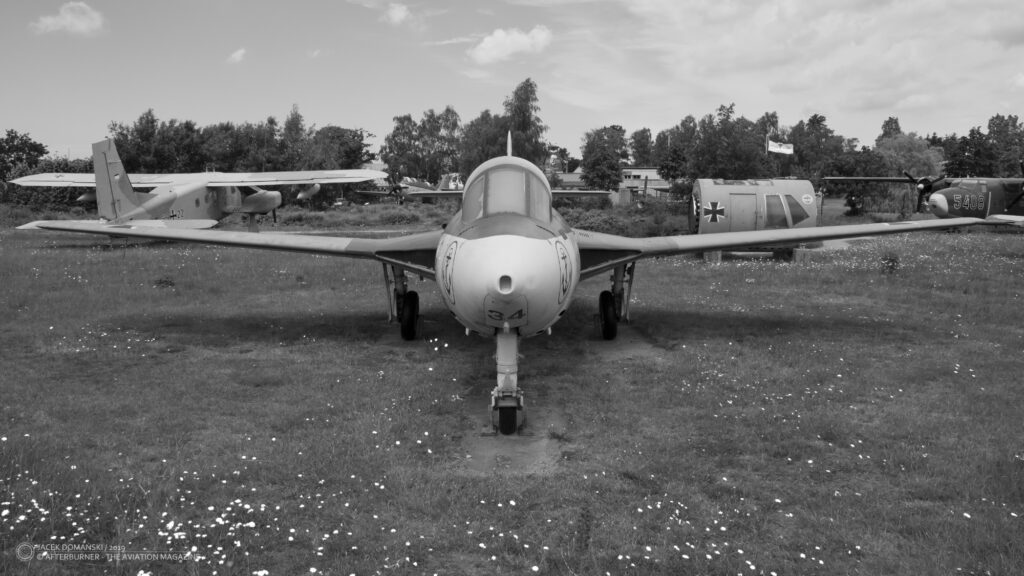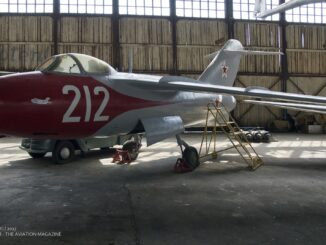 On 2nd September 1947, prototype of new Hawker jet aircraft designated P.1040 (VP401) or, following its naval designation, N.7/46, performed its first flight. Two years later, the aircraft was approved for serial production and received an official name Hawker Sea Hawk.
On 2nd September 1947, prototype of new Hawker jet aircraft designated P.1040 (VP401) or, following its naval designation, N.7/46, performed its first flight. Two years later, the aircraft was approved for serial production and received an official name Hawker Sea Hawk.
Already in 1944, Hawker Aircraft Ltd. began its first development of a jet-powered fighter aircraft. It was based on Hawker Sea Fury airframe and Rolls-Royce Nene and Derwent turbojet engines were considered as its powerplant. That project, commonly known as P.1035 did not meet with much enthusiasm by the Air Ministry. The Sea Fury was a huge aircraft, powered by a powerful piston engine, therefore replacing its powerplant by single jet engine of 2.000 lbf maximum thrust (being approximately just an equivalent of 2.500 hp generated by the Sea Fury engine), together with increasing weight of the aircraft itself, would never work out.
As a consequence, the Hawker company decided to significantly redevelop its initial design. Nevertheless, still with lack of interest from the Air Ministry, therefore the project was continued as a private venture of the company. The new aircraft, officially designated P.1040 was created under direct supervision of Sydney Camm, famous aviation engineer known from his World War II fighters – such as Hurricane, Typhon and Tempest – at that time working as chief designer at Hawker.
Similarly to the Sea Fury, the project of the new fighter was sent for further evaluation to the Royal Air Force and the Royal Navy. Regrettably, without any success. The RAF already focused on implementing two other jet-powered fighters – Gloster Meteor and de Havilland Vampire – having no interest in adding another interceptor to its fleet. And the RN was already involved with its first naval jet project, known as Supermarine Attacker.
Even so, Hawker did not abandon its new development but, in view of no success with the RAF, the company focused on the naval variant only. In January of 1946, yet another version of the jet was proposed to the Admiralty, now designated P.1046 and defined as fleet support fighter.
The RN authorities were still sceptical but the Hawker´s design promised the greater range than Attacker, being one of the most important performance characteristics from the Navy´s point of view. Eventually, in May of 1946, production of three prototypes was ordered by the Navy, following the recently issued Specification N.7/46.

On 2nd September 1947, the first prototype of the new fighter took-off for its maiden flight. Although made in response to the RN order specification, it was still in configuration of the earlier P.1040 variant, originally intended for the RAF. At that time Hawker was still hoping to sell its first jet to the air force, therefore used the opportunity to test the initial version of the aeroplane. The naval prototype – equipped with folding wings, catapult spools and arrester hook – performed its first flight almost one year later, on 31st August 1948. Shortly thereafter, it was transferred to Boscombe Down station where deck trials took place, using a mock-up deck of an aircraft carrier. Then, in April of 1949, the prototype performed several trials at sea, this time from deck of a real carrier, HMS Illustrious.
In November of 1949, the new Hawker jet was eventually approved by the RN and allowed for serial production, officially named Sea Hawk and initial order for 151 aircraft was placed.
The first serial aeroplane was ready in 1951. Two years later, the Sea Hawks officially entered their service with No. 806 Naval Air Squadron. The Sea Hawk was evaluated by Australian and Canadian navies, but finally none of them decided to purchase that naval jet. Nevertheless, the aircraft achieved a small success in foreign sales – 68 jets were ordered by Bundesmarine (Germany), another 30 were acquired by the Royal Netherlands Navy (being financed by the NATO) and, finally, 24 Sea Hawks were bought by India. Later, the Indian Navy also bought some retired Sea Hawks from the RN, as well as acquired a few additional ones from Germany.
The Hawker Sea Hawk was powered by Rolls-Royce Nene Mk.101 or Mk.103 engines and made in a few specialized variants. They include Sea Hawk F1 basic naval fighter, FB.3 fighter-bomber, FGA.4 fighter/ground attack aircraft, Mk.50 ground attack version for the Dutch Navy, as well as Mk.100 and Mk.101 export variant for the German Navy (the latter being an upgraded all-weather variant).
Combat history of the Sea Hawk includes the so-called Suez Crisis of 1956, the Dutch Navy operations in the Far East, as well as Indo-Pakistani wars of 1965 and 1971.
Although the Sea Hawk was considered good and reliable aeroplane, its conventional design and low maximum speed meant it could be considered only as a temporary solution. Faced with rapid development of aviation during the Cold War era, an aircraft with its design originating directly from the World War II aeroplanes quickly became too obsolete. Therefore, the Sea Hawk managed to stay in the first line for approximately only ten years.
The Royal Navy retired all the Sea Hawks already between 1958 and 1960, although some aircraft were still operated by Fleet Requirements Unit until 1969. The Netherlands withdrawn the Hawker naval jet in 1964 and the German Marineflieger retired the Sea Hawk in the mid-1960s. Nevertheless, with the Indian Navy, the last Sea Hawks remained operational until 1983.

Cover photo: Hawker Sea Hawk Mk.101, German naval aviation (Marineflieger), gate guard at Aeronauticum aviation museum in Nordholz.



